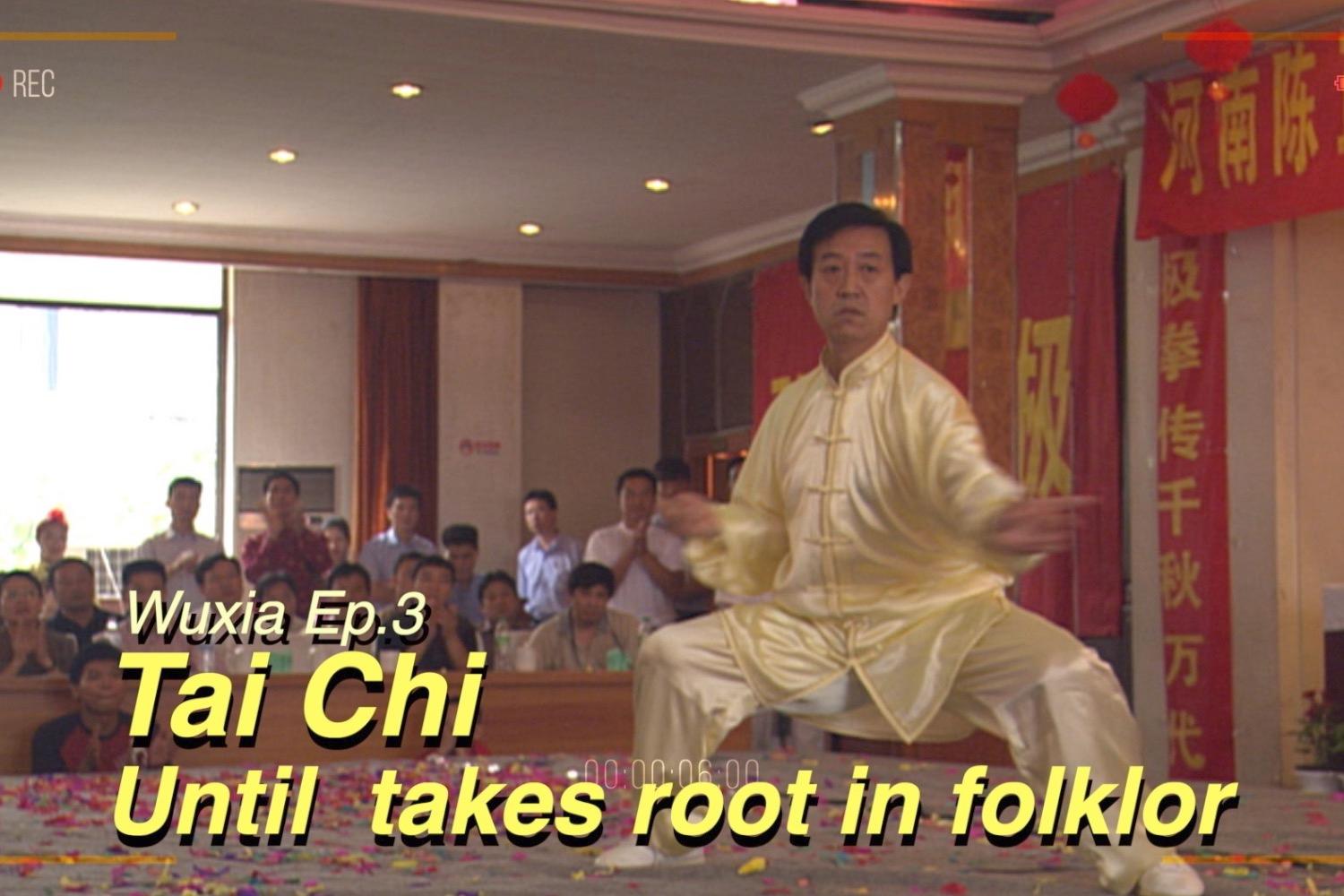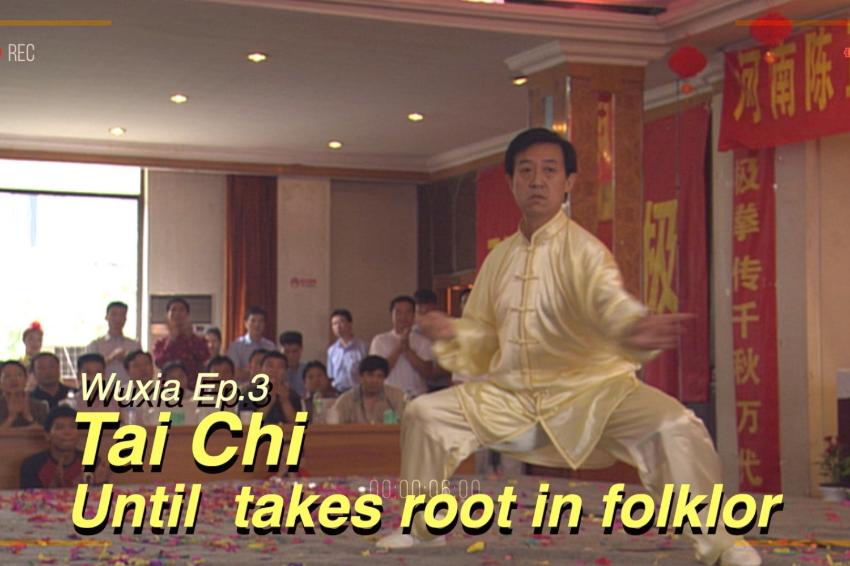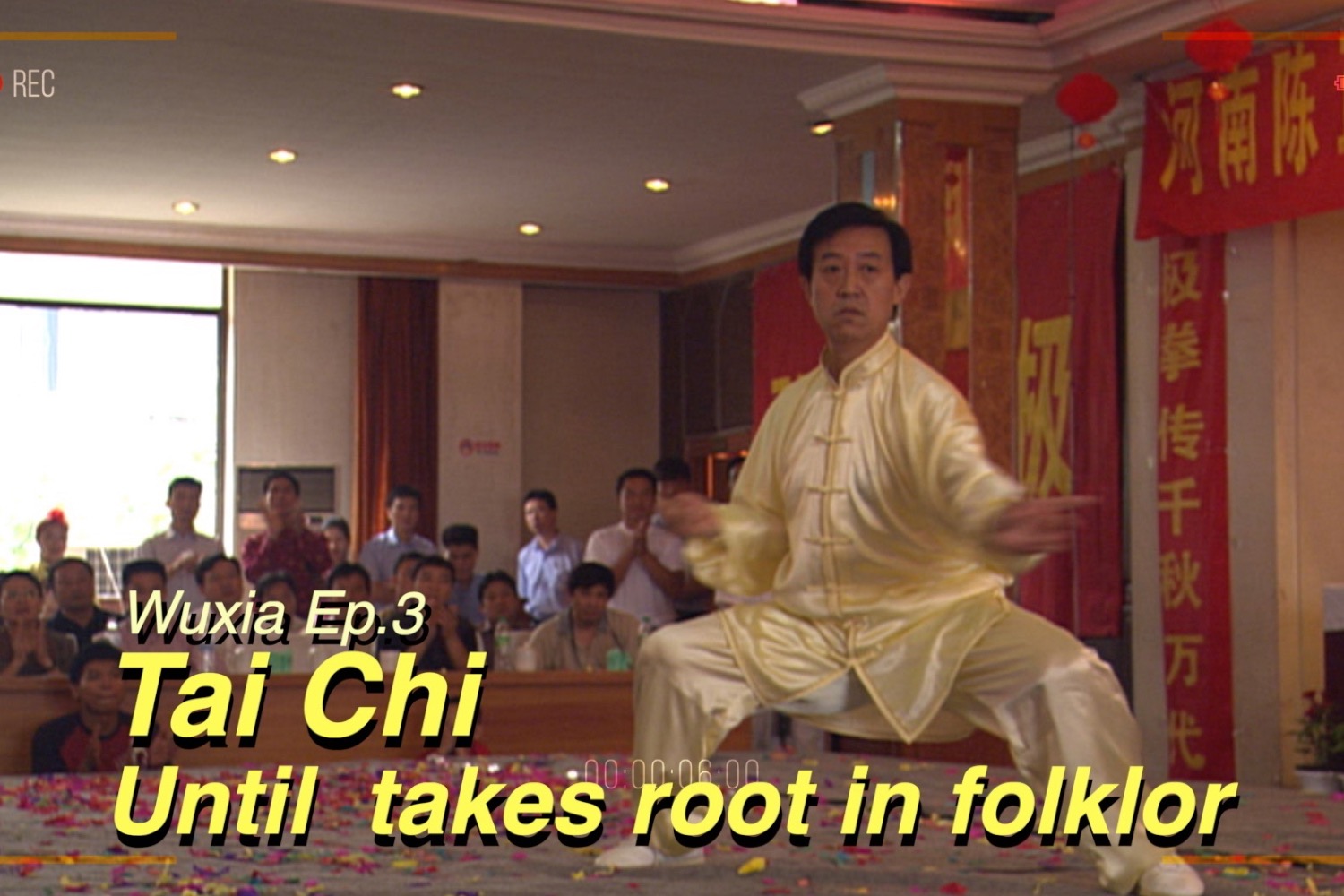2003년 다큐멘터리
생활 속의 무술(武術)
무협(武俠) 3화
[태극권(太極拳)이 민간에 뿌리내리기까지]
- 정주(郑州 정저우) 들썩이는 분위기
2003년 8월. 매년 이날이면 정주(郑州) 시가 들썩인다.
진가구(陳家溝) 태극권(太極拳) 학교 설립을 기념하는 행사가 열리기 때문이다.
- 진정뢰(陳正雷) 개회사
올해 기념식은 정주(郑州) 시의 호텔을 빌려 성대하게 치러졌다.
중국정부의 고위 간부들과 무술계의 고수들도 초대됐다.
- 소림권(少林拳) 시범
행사의 하이라이트는 무술 시범.
소림권(少林拳), 취권(醉拳), 팔극권(八極拳) 등 다양한 무술이 선을 보였다.
소림권(少林拳)은 대표적인 외공(外功) 위주의 무술이다.
외공(外功)이란 신체단련을 통해 파괴력을 만드는 무술을 말한다.
- 진정뢰(陳正雷) 진식 태극권(太極拳) 시범
반면 태극권(太極拳) 같은 내가권(內家拳)은 호흡을 통해 몸안의 기(氣)를 운용해 힘을 발휘한다.
따라서 몸과 마음이 조화로운 상태를 이루게 한다.
이런 장점 때문에 진가구(陳家溝)에서 태동된 태극권(太極拳)은 수세기를 거치면서 다양한 형태로 분화됐다.
- 태극권(太極拳) 5대 문파 시범
현재 태극권(太極拳)은 진가구(陳家溝)의 진식(陳式)을 비롯해 양식(楊式), 오식(吳式), 무식(武式), 손식(孫式) 등 5개 문파가 전해진다.
그중에서 가장 대중적인 것이 양식(楊式) 태극권(太極拳)이다.
동작이 쉬우면서 순하고 부드럽기 때문에 중국 정부에서 만든 보급형 태극권(太極拳)의 기초가 됐다.
약 200년 전 청나라때 진가구(陳家溝) .
- 양로선(杨露禅) 동상
하북 사람인 양로선(杨露禅)은 이곳 진씨 집안에서 잡일을 하던 사람이었다.
총명하고 성실한 양로선(杨露禅은 무술에도 관심이 많아서 밤낮으로 태극권(太極拳)을 연마한다.
- 진장홍(陳張洪) 과 양로선 벽화
감복한 진가구(陳家溝)의 14대손 진장홍(陳張洪)은 장손에게만 전수하던 원칙을 깨고 그에게 태극권(太極拳)을 전수한다.
그뒤 양로선(杨露禅)은 청나라 황실에까지 태극권(太極拳)을 가르치게 된다.
그 과정에서 어려운 동작들을 쉽고 부드럽게 만들어 진식과는 다른 문파를 형성하게 된 것이다.
- 도교(道敎) 사원
그렇다면 태극권(太極拳)의 생명력은 어디에서 찾아질 수 있을까?
그것은 중국 민간에 깊숙히 뿌리내린 도교(道敎) 문화와 관계가 깊다.
- 왕영기(王英琦) 안휘성도가협회 부회장 작가 인터뷰
(태극권(太極拳)은 도가(道家) 문화의 산물입니다.
주역은 도교(道敎) 문화의 이론의 기초입니다.
그 이유는 음과 양이 대립하고 상호 보완하기 때문입니다.
도교의 본질은 대립을 통해 상호 대칭을 이루는 것입니다.
대립을 이루면서 통일되는 관점이 있습니다.
태극권(太極拳)의 본질의 핵심은 바로 이런 모순의 절충입니다.)
- 도인양생공(導引養生功) 시범
모순의 절충을 통해서 도가(道家)에서 추구하는 것은 자기 내면의 수양, 즉 인격체의 완성이다.
이런 도가(道家)적 수련법을 최근 베이징체 육대학에서는 도인양생공(導引養生功)으로 체계화했다.
이 수련법은 조심(調心), 조흡(調吸), 조형(調形) 세가지로 이뤄져 있는데,
그중 가장 중요한 것이 마음을 다스리는 조심(調心)이다.
- 장광덕(張廣德) 북경체육대학교 교수 인터뷰
(조심(調心)은 대뇌를 정화한다. 잡념을 버리게 한다.
손을 단전에 모으고 마음을 하나로 모은다.
일념을 통해...만념을 없앤다.
대뇌를 통해 마음을 수양한다.
이를 위해서는 호흡도 필요하다. 이것을 조흡(調吸)이라고 한다.
때로는 길게 들이쉴 때가 있고,,, 때로는 길게 내뱉을 때도 있다.
때로는 또 반대로...숨을 들이마시는 것이 짧고...내 뱉는 것이 길때가 있고...
또 때로는...같을 경우도 있다.)
- 도인양생공(導引養生功) 시범
이런 바탕 위에서 태극권(太極拳)은 살상용 무술이 아닌 자기완성을 위한 무술로 발전돼 온 것이다.
2003 documentary
Martial Arts in Life
Chinese Hero: Wuxia Ep.3
[Until Tai Chi(太極拳) takes root in folklore]
- Zhengzhou city
August 2003.
Every year on this day, the city of Zhengzhou is lively.
This is because an event is held to commemorate
the establishment of the Chenjiagou Tai Chi School.
- Opening remarks by Chen Zhenglei
This year's ceremony was held in a grand way
by renting a hotel in Zhengzhou City.
High-ranking Chinese government officials
and martial arts experts were also invited.
- Demonstration of Shaolinquan
The highlight of the event is a martial arts demonstration.
Various martial arts, such as Shaolinquan (少林拳), Chwiquan (醉拳),
and Bajiquan (八極拳) were showcased.
Shaolinquan (少林拳) is a typical martial art that focuses on external work.
External quan is a martial art that creates
destructive power through physical training.
- Demonstration of Chen-style Tai Chi
On the other hand, Internal quan (內家拳), such as Tai Chi(太極拳),
exerts power by operating the qi (气) in the body through breathing.
Thus, the body and mind achieve a harmonious state.
Because of these advantages, Tai Chi, born in Chenjiagou,
has been differentiated into various forms over the centuries.
- Demonstration of five Tai Chi families
Currently, Tai Chi is handed down into five schools,
including Chen-style, Yang-style, Wu-style, Mu-style and Sun-style.
Among them, the most popular form is Yang-style Tai Chi.
Because it is easy to move, gentle and soft, it became the basis
for the entry-level Tai Chi created by the Chinese government.
- Statue of Yang Luchan
About 200 years ago, during the Cheng Dynasty, Chenjiagou.
Yang Luchan (杨露禅), a native of Hebei,
was a man who worked in the Chen family here.
The intelligent and sincere Yang Luchan is also interested in martial arts,
so he practices Tai Chi day and night.
- Chen Zhanghong and Yang Luchan mural
Chen Zhanghong (陳張洪), the 14th grandson of the conquered
Chenjiagou breaks the principle passed down
only to his eldest grandson and passes on Tai Chi(太極拳) to him.
After that, Yang Luchan (杨露禅) taught Tai Chi to the Cheng imperial family.
In the process, difficult movements were made easy and smooth,
forming a different class from Chen-style.
- Taoist Temple
If so, where can the vitality of Tai Chi be found?
It is closely related to the Taoist culture deeply rooted in Chinese folklore.
- Interview with Wang Yingqi, vice president of Anhui Association
(Tai Chi is a product of Taoist culture.
The protagonist is the basis of the theory of Taoism culture.
The reason is that yin and yang oppose and complement each other.
The essence of Taoism is to achieve mutual symmetry through opposition.
There is a point of view that is unified by forming opposition.
The essence of Tai Chi is the compromise of these contradictions.)
- Demonstration of Daoyin Health Gong
What the Taoist seeks through the compromise of contradictions is self-cultivation,
that is, the perfection of the person.
This Taoist training method was recently systematized as
Daoyin Health Gong (導引養生功) at Beijng Sports College.
This training method consists of three parts:
careful mind, breathing, and shaping.
The most important of these is the mind to control.
- Interview with Professor Zhang Guangde, Beijing Sports College
(Carefulness purifies the cerebral cerebrum.
It makes you throw away thoughts.
Put your hands together and bring your hearts together.
Through one thought... get rid of all thoughts.
Cultivate the mind through the cerebrum.
This also requires breathing. This is called premature breathing.
Sometimes I breathe in long, sometimes I breathe out long.
Sometimes and vice versa... breathing in is short... exhaling is long...
And sometimes... it's the same.)
- Demonstration of Daoyin Health Gong
On this basis, Tai Chi has been developed as a martial art for self-fulfillment,
not a martial art for killing.







